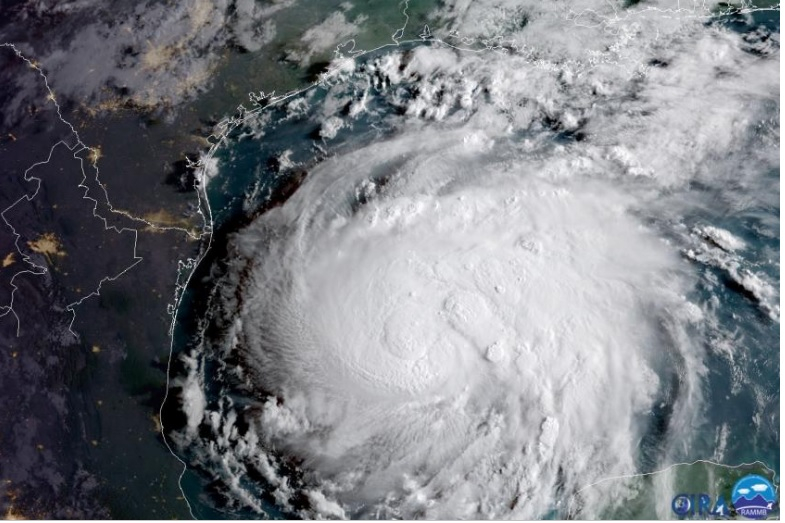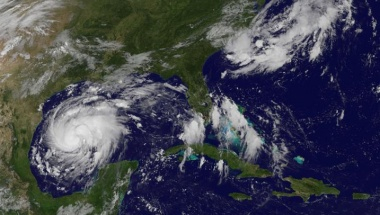
Chicago: Millions of people in the US Gulf Coast states of Texas and Louisiana braced for the arrival of Hurricane Harvey as it intensified to Category 4 hurricane.
Hurricane Harvey was hours away from lashing the Texas coast on Friday with winds of up to 125 mph (202 kph) and 12-foot ocean surges as the most powerful storm in over a decade bore down on the mainland US.
Harvey strengthened to a powerful Category 4 hurricane with flood warnings in effect for Louisiana and northern Mexico, the National Hurricane Center said.
The storm was expected to hit land near Corpus Christi, Texas, around 9 pm CDT (0200 GMT, 6am in Dubai) then stall and dump over three feet (90 cm) of rain in areas of the Texas coast and parts of Louisiana as it lingers for days.
Evacuation
Businesses closed and lines of cars streamed out of coastal Texas as officials called for residents to evacuate ahead of Harvey, expected to arrive about midnight as the most powerful storm to hit the US mainland in more than a decade.
The US National Hurricane Center (NHC) warned that Harvey was “dangerously approaching” the Texas Coast and creating a potential for “life-threatening and devastating” floods as it roared toward an area that processes some seven million barrels of oil a day.
What Hurricane Harvey looks like from space: https://t.co/wjO0FguXYM pic.twitter.com/84LWuSYJXR— CNN (@CNN) August 25, 2017
The storm’s centre was due to make landfall late Friday or early Saturday, with preceding strong winds arriving as early as 8am (1300 GMT, 5pm in Dubai) Friday.
Harvey was bearing northwest at nine miles (15 kilometres) per hour as of 4am central time (0900 GMT), but the NHC said the category one hurricane could hit land as a much more powerful category three, with winds of 209 kilometres per hour.
If forecasts hold, Harvey would be the strongest hurricane to hit the US mainland in 12 years.
“For anyone who has not already evacuated, please hurry to do so,” the city of Portland, Texas declared on its website in capital letters.
Refiners affected
The storm was threatening one-third of the US refining capacity, forcing several energy companies to take precautions and evacuate personnel from oil and gas platforms in the heart of the US “Refinery Row.”
One oil drilling rig in the Gulf of Mexico was evacuated Thursday, as well as 39 manned oil and natural gas production platforms, according to the Bureau of Safety and Environmental Enforcement.
Those evacuations represented an estimated 9.5 per cent of oil production and 14.7 per cent of natural gas production in the Gulf, the Bureau said.
The storm was expected to dump as much as 89 centimetres of rain in some parts of Texas.
Dangerous storm surges were also forecast to reach between 1.8 and 3.7 metres above ground level in the worst-hit regions.
Texas Governor Greg Abbott issued disaster declarations in 30 counties, saying the pre-emptive move would allow the state “to quickly deploy resources for the emergency response effort”.
Officials in Houston, the biggest city in the path of the storm, said they did not anticipate issuing evacuation orders, but expected heavy rainfall to last up to five days. City schools cancelled classes through Monday.
“Houston will see close to 20 inches [50cm] of rainfall,” officials said in a statement.
“This is likely to cause dangerous flash flooding, and will cause area flooding throughout the entire Houston region.”
Corpus Christi — a major oil refining centre where the hurricane was projected to make landfall Saturday morning — issued voluntary evacuation orders. The nearby coastal hamlets of Port Arkansas and Arkansas Pass both ordered mandatory evacuations.
A number of other municipalities in Texas also ordered evacuations.
US President Donald Trump weighed in with a tweet: “As #HurricaneHarvey intensifies — remember to #PlanAhead.”
In neighbouring Louisiana where the storm was forecast to hover for many days and could deluge flood-prone New Orleans, Governor John Bel Edwards said he spoke with the president who “offered his full support.”
“This is going to play out over the next week or so,” Edwards told a news conference, “which makes it particularly dangerous ... because the longer it sits in one place the more rain that it will drop.”
Edwards issued an emergency declaration for his entire state, as hundreds of boats were made ready for potential rescues along with more than half a million sandbags to hold back flood waters.
In New Orleans, where Hurricane Katrina in 2005 caused widespread flooding and killed more than 1,800 people, Mayor Mitch Landrieu told journalists that high-water rescue vehicles and boats were at the ready.
“We just need to make sure that we’re prepared for heavy rain over the course of the next week,” Landrieu said, adding that there were no evacuations planned.
Major storm
This is the first major storm of the annual Atlantic hurricane season.
The Gulf region is only midway through the season, and has so far had eight storms that did not cause much concern, said Phil Klotzbach, an atmospheric scientist at Colorado State University.
“The tropical Atlantic remains warmer than normal,” Klotzbach told journalists, “so we are expecting an above-average overall season.”
According to analyst Phil Flynn of the Price Futures Group, the region in Harvey’s path is vital to the US refining industry “running about seven million barrels a day.”
“Harvey’s greatest risk to refiners is not just wind damage to the refineries, but also the associated rainfall and the potential for electric power failure,” said James Williams of WTRG Economics.
Should a refinery shut down, he said it could take a week to get it up and running again.














